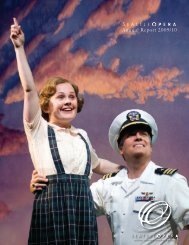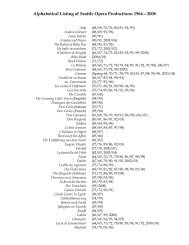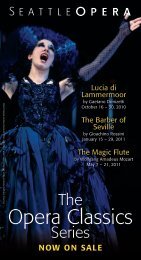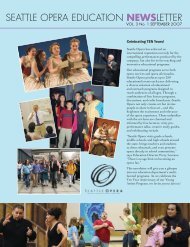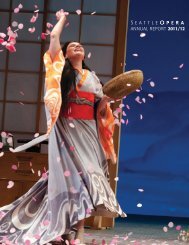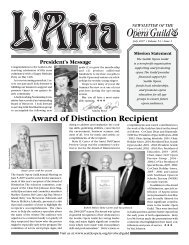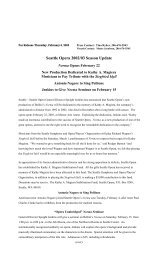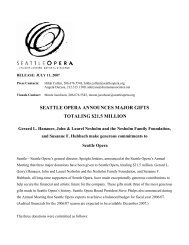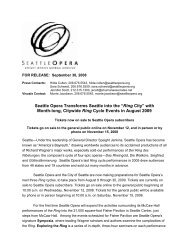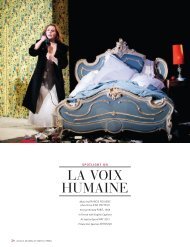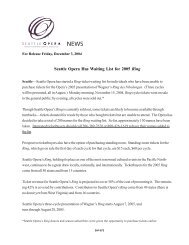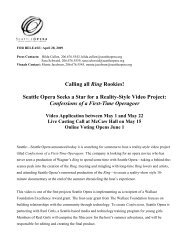Press Kit - Seattle Opera
Press Kit - Seattle Opera
Press Kit - Seattle Opera
Create successful ePaper yourself
Turn your PDF publications into a flip-book with our unique Google optimized e-Paper software.
Wagner at <strong>Seattle</strong> <strong>Opera</strong><br />
<strong>Press</strong> <strong>Kit</strong><br />
“In <strong>Seattle</strong>, Glynn Ross audaciously resolved to mount Wagner’s<br />
Ring of the Nibelung every summer in both German and English,<br />
starting in 1975. Speight Jenkins, who took over the <strong>Seattle</strong> <strong>Opera</strong><br />
in 1983, is an equally zealous Wagnerite (the office closes for<br />
Wagner’s birthday) who insisted on world- class music and<br />
production values. This meant relinquishing Ross’s annual Ring in<br />
favor of more-varied summer repertoire keying on fresh<br />
productions of Lohengrin, the Ring, Tristan, Die Meistersinger,<br />
and Parsifal. <strong>Seattle</strong>’s 1986 Ring, directed by Francois Rochaix<br />
and designed by Robert Israel, remains the only North American<br />
version with the intellectual panache of Patrice Chereau’s<br />
landmark Bayreuth Ring of 1976. <strong>Seattle</strong>’s 2001 Ring, directed by<br />
Stephen Wadsworth, was hyperrealistic yet psychologically astute.<br />
Both productions were cast not according to glamorous past<br />
exposure but actual competence shrewdly assessed; both were<br />
complemented by first-rate Wagner lectures and (an amenity<br />
unknown at Lincoln Center or Carnegie Hall) a serious bookstore.<br />
The one Ring secured and the other consolidated <strong>Seattle</strong>’s status as<br />
the leading North American Wagner house.”<br />
Joseph Horowitz<br />
Classical Music in America
<strong>Seattle</strong> <strong>Opera</strong> Public Programs and Media Department<br />
Jonathan Dean<br />
Director of Public Programs and Media<br />
206.676.5543<br />
jonathan.dean@seattleopera.org<br />
Tamara Vallejos<br />
Public Programs and Media Associate<br />
206.676.5559<br />
tamara.vallejos@seattleopera.org<br />
For visuals (digital photographs or video):<br />
Monte Jacobson<br />
Public Relations Coordinator<br />
206.676.5545<br />
monte.jacobson@seattleopera.org<br />
<strong>Press</strong> releases and other information also available at:<br />
http://www.seattleopera.org/news
Five Decades of Wagner in <strong>Seattle</strong>: 1966-2013<br />
1966 Lohengrin (2 performances)<br />
1972 Der Fliegende Holländer (5 performances)<br />
1973 RING 1 INTRODUCED: Die Walkiire (5 performances)<br />
1974 Siegfried (6 performances)<br />
1975 Götterdämmerung (6 performances)<br />
1975 Der Ring des Nibelungen (1 cycle in German, 1 in English)<br />
1976 Der Ring des Nibelungen (1 cycle in German, 1 in English)<br />
1977 Der Ring des Nibelungen (1 cycle in German, 1 in English)<br />
1978 Der Ring des Nibelungen (1 cycle in German, 1 in English)<br />
1979 Der Ring des Nibelungen (1 cycle in German, 1 in English)<br />
1980 Der Ring des Nibelungen (1 cycle in German, 1 in English)<br />
1981 Tristan and Isolde (6 performances)<br />
1981 Pacific Northwest Wagner Festival:<br />
Der Ring des Nibelungen (1 cycle in German, 1 in English)<br />
Tristan und Isolde (1 performance)<br />
1982 Der Ring des Nibelungen (1 cycle in German, 1 in English)<br />
1983 Der Ring des Nibelungen (1 cycle in German, 1 in English)<br />
1984 Der Ring des Nibelungen (1 cycle in German)<br />
1984 Tannhäuser (5 performances; SUPERTITLES INTRODUCED)<br />
1985 RING 2 INTRODUCED: Die Walküre (3 performances)<br />
1986 Der Ring des Nibelungen (2 cycles in German with supertitles)<br />
1987 Der Ring des Nibelungen (2 cycles)<br />
1989 Der Fliegende Holländer (6 performances)<br />
1989 Die Meistersinger von Nürnberg (7 performances)<br />
1991 Der Ring des Nibelungen (3 cycles)<br />
1994 Lohengrin (5 performances)<br />
1995 Der Ring des Nibelungen (3 cycles)<br />
1998 Tristan und Isolde (10 performances)<br />
2000 Das Rheingold (3 performances) and Die Walküre (7 performances)<br />
2001 Der Ring des Nibelungen (3 cycles)<br />
2003 Parsifal (9 performances)<br />
2004 Lohengrin (8 performances)<br />
2005 Der Ring des Nibelungen (3 cycles)<br />
2006 International Wagner Competition<br />
2007 Der Fliegende Holländer (8 performances)<br />
2008 International Wagner Competition<br />
2009 Der Ring des Nibelungen (3 cycles)<br />
2010 Tristan und Isolde (7 performances)<br />
2013 Der Ring des Nibelungen (3 cycles)
Wagner at <strong>Seattle</strong> <strong>Opera</strong><br />
From Glynn Ross's first production of Wagner's Lohengrin in 1966 to Speight Jenkins'<br />
presentations of all ten of Wagner's major works, <strong>Seattle</strong> <strong>Opera</strong>’s continued emphasis on the<br />
music dramas of Richard Wagner is a key component of our mission and has made <strong>Seattle</strong> a<br />
can’t-miss destination for Wagnerians around the world.<br />
Why are the works of Richard Wagner so important to <strong>Seattle</strong> <strong>Opera</strong>? In the early 1970s, the<br />
founder of the company, Glynn Ross, who loved the operas of the German composer, realized<br />
that in the United States over the previous twenty years there had been less Wagner performed<br />
and that the mammoth work of the composer, Der Ring des Nibelungen, was receiving far fewer<br />
performances than it had since its introduction to the United States in the 1880s. At that time,<br />
only one major company, the Metropolitan <strong>Opera</strong>, had part of a Ring production, and because of<br />
complicated problems, the final opera of the cycle, Götterdämmerung, had not yet been<br />
completed. San Francisco and Chicago, both of which companies that had produced the Ring in<br />
the past, seemed to have no plans now for producing the cycle, and no other opera company in<br />
America was contemplating its production. Due to the apparent dislike of Wagner by the<br />
Metropolitan’s General Manager, Rudolf Bing, who was about to retire, the company had<br />
produced far few Wagner operas than in the past, and this was at a time when one of the greatest<br />
Wagnerian sopranos of the twentieth century, Birgit Nilsson, was at the height of her personal<br />
popularity and critical acclaim.<br />
With all this happening in other opera companies, Ross looked around him in <strong>Seattle</strong> and saw a<br />
terrain that to him that suggested the Alpine reaches of Bavaria with our lakes and evergreens.<br />
He also believed that the audience in <strong>Seattle</strong>, up to then exposed only either to touring Wagner<br />
productions or to two of the earlier Romantic operas by Ross’s less-than-a-decade-old <strong>Seattle</strong><br />
<strong>Opera</strong>, would take to the Ring. Ross had spent the summers of 1953 and 1954 working at the<br />
Bayreuth Festival. And, clever entrepreneur that he was, he perceived that since the Bayreuth<br />
staging revolution of 1950, created by the two grandsons of the composer, Wieland and<br />
Wolfgang Wagner, all productions of the Ring were eschewing the rocks and mountain scenes<br />
associated with Wagner’s own Ring in 1876 as well as the stage directions in his librettos. Ross<br />
reasoned that if he could create a Ring evoking the memory of the past, many from all over the<br />
country and, conceivably, the world would come.<br />
That year was so successful that Ross convinced the <strong>Seattle</strong> <strong>Opera</strong> Board that the Ring should be<br />
repeated, and the audiences and press came from even farther away. Soon the annual summer<br />
cycles of the Ring (one in German, one in English) became a tradition and were repeated every<br />
year. In 1980, Ross presented a new production of Tristan und Isolde. In the summer of 1981, he<br />
presented a performance of that work between the two cycles of the Ring.<br />
The repetition established <strong>Seattle</strong> <strong>Opera</strong> worldwide as a Ring center. It also inculcated into the<br />
<strong>Seattle</strong> <strong>Opera</strong> public a liking for Wagner’s works and a familiarity with them that is probably<br />
still greater per capita than in any city outside Germany.
Speight Jenkins was appointed general director of the company in 1983. A lawyer and by trade a<br />
journalist, Jenkins had previously worked as a music critic, a radio and TV commentator, and a<br />
speaker on opera. One characteristic might have increased his appeal to the Board’s search<br />
committee: he was an ardent Wagnerian who believed in the future of the <strong>Seattle</strong> Ring and was<br />
eager to create a new Ring production for <strong>Seattle</strong>. The Ring was not the limit of his desire for<br />
Wagner at <strong>Seattle</strong> <strong>Opera</strong>. Shortly after his appointment, he said that he wanted to produce all ten<br />
of the standard canon of Wagner’s works at <strong>Seattle</strong> <strong>Opera</strong>, and he proposed to begin in the first<br />
season he planned with Tannhäuser.<br />
In the ensuing twenty-five years, Jenkins has done what he promised to do. In August of 2003, a<br />
new production of Parsifal completed the canon, enlarged as it has been by the creation of two<br />
complete Rings, two Tristan und Isoldes, and multiple productions of Der Fliegende Holländer<br />
and Lohengrin. Over these years, the company has enhanced its reputation for Wagner<br />
productions, productions created in a variety of styles and with many of the greatest singers of<br />
Wagner. The company is now held to the highest possible standard by the world press.<br />
Audiences come to Wagner performances from all 50 states and as many as 20 foreign countries.<br />
The non-Ring operas as well as the Ring attract interested audiences, and local support for<br />
Wagner has grown exponentially over the years.<br />
The Ring cycles in 2001 and 2005 Ring were completely sold out before the opening, and ticket<br />
sales for the 2009 Ring were strong. Other summer productions of Wagner, presented as parts of<br />
<strong>Seattle</strong> <strong>Opera</strong>’s subscription season, are always well attended, and the company's International<br />
Wagner Competition, inaugurated in 2006 and held again in 2008, received an enthusiastic<br />
response from its audience.
Review Quotes of Wagner Productions<br />
Ring 1 (1972-1984)<br />
Few companies outside of Bayreuth have performed Wagner’s Ring des Nibelungen regularly in<br />
its entirety, but under founding General Director Glynn Ross, <strong>Seattle</strong> <strong>Opera</strong> performed it every<br />
summer from 1975 through 1984. Under Ross, <strong>Seattle</strong> <strong>Opera</strong> presented the Ring in German and<br />
English in back-to-back cycles (1975-1983). In the days before supratitles, Andrew Porter's<br />
English adaptation introduced many Wagner neophytes to the complexity of the libretto.<br />
To judge by their writing, many critics were amazed this Ring was happening in a remote<br />
location of the United States, unknown to the world press for anything other than Boeing planes<br />
and a high annual rain count. Microsoft, Starbucks, and grunge music were still years away from<br />
registering <strong>Seattle</strong> on the world’s arts and culture map. But fans of opera knew that <strong>Seattle</strong> was<br />
becoming a major stop in any Wagner tour. By 1982, The New York Times reported that <strong>Seattle</strong><br />
had become a serious rival to Bayreuth, drawing fans from all over the United States, Indonesia,<br />
Chile, South Africa, Switzerland, Tasmania, Saudi Arabia, Mexico, and Europe.<br />
The production was designed by John Naccarato and originally directed by George London.<br />
Later presentations of the production were directed by Lincoln Clark (1976-1983) and Ragnar<br />
Ulfung (1984). Henry Holt conducted all the cycles.
“It seems only yesterday that it was an impossible dream to present the Ring in America in its<br />
complete form. Back in 1953, when it was my good fortune to work at Bayreuth, my first<br />
viewing of the Ring had an impact on me which lasted a lifetime. Bringing the Ring to America<br />
has been a great privilege and the most fulfilling accomplishment of my entire life.”<br />
—Glynn Ross, Program Introduction to the fifth Ring Cycle.<br />
“<strong>Seattle</strong>’s huge opera house...was packed and repacked last month with pilgrims from all over<br />
the world....This festival...has established itself as the industrial world’s popular alternative to the<br />
Bayreuth Festival.”<br />
—Robert F. Ellsworth, The Wall Street Journal, August 14, 1981<br />
“Mr. and Mrs. Jan Kwist came from South Carolina in a camper truck, with a tuxedo for him and<br />
a long dress for her. William Cord, a Californian, timed his open heart surgery a few weeks ago<br />
so he could be here…They are among the thousands of people converging here this week to<br />
attend the opera. The opera? In <strong>Seattle</strong>? This city at the Northwest corner of the nation, best<br />
known for Boeing 747’s, sourdough, and sockeye salmon, has casually mounted one of the most<br />
ambitious operatic projects ever taken in the United States.”<br />
—Robert Lindsey, The New York Times, July 1975<br />
“Once we did [the Ring], we were on the map. Even the Germans recognized it. Richard Wagner<br />
in wildern Westen was one of the headlines in OpernWelt.”<br />
—Archie Drake [Company member, Gunther in both German and English Rings from 1975 to<br />
1980), 2001 interview conducted by Jonathan Dean<br />
“For opera buffs, it has been a smash. Night after night the murky doings onstage have had the<br />
audience standing and cheering in the 3,000-seat <strong>Opera</strong> House.”<br />
—John Brewer, Associated <strong>Press</strong>, August 1977<br />
“With swashbuckling frontier brashness, the <strong>Seattle</strong> <strong>Opera</strong> is presenting its fourth annual<br />
complete cycle…”<br />
—Amei Wallach, Newsday, July 1978<br />
“They cheered. They bravoed. They flung carnations on to the stage and stood applauding for 20<br />
minutes on the final night, refusing to go home. This was the kind of mass frenzy which broke<br />
out at <strong>Seattle</strong> <strong>Opera</strong>’s performances of Wagner’s Ring Cycle this summer, as if a new religion<br />
had come to town.”<br />
—The London Evening Standard, August 1981
Tannhäuser<br />
1985, 5 Performances<br />
The production, by Robert E. Darling, was conducted by Hermann Michael.<br />
“Most opera buffs know <strong>Seattle</strong> for its Ring, which has been produced here each summer since<br />
1975 (a new Walküre will be unveiled next summer, with a complete new Ring production to<br />
follow in 1986). Jenkins seems intent on extending the city's Wagnerian reputation by adding<br />
further productions to the company's repertoire—a process that may have happy results, if the<br />
quality of the new Tannhäuser is any indication.”<br />
—Melinda Bargreen, Musical America, “Report from <strong>Seattle</strong>,” March 1985<br />
“To find a pair of tenors capable of handling merely the vocal demands of a role like Tannhäuser<br />
is not easy these days, and it argues well for the management's astuteness that in Edward Sooter<br />
and, especially, William Cochran, it offered two tenors who combine intelligence with stamina.”<br />
—Dale Harris, The Guardian, “An uneasy blend of stars and stripes,” December 21, 1984<br />
“Hermann Michael, in his American debut, was in the pit—a notable performance.”<br />
—R.M. Campbell, <strong>Seattle</strong> Post-Intelligencer, “A Tannhäuser worth the wait,” November 5,<br />
1984<br />
“While many have come to associate <strong>Seattle</strong> <strong>Opera</strong> with Wagner because of the decade of<br />
summertime Ring cycles, the current production of Tannhäuser underscores the connection.<br />
When it comes to Wagner, <strong>Seattle</strong> <strong>Opera</strong> apparently can't be beat.”<br />
—Will Stuivenga, Jounal American, “<strong>Seattle</strong> <strong>Opera</strong> produces a stunning Tannhäuser,”<br />
November 6, 1984<br />
“<strong>Seattle</strong> <strong>Opera</strong>’s first Tannhäuser on November 3 also brought the company’s first use of<br />
Supratitles... the absorbed audience attention on opening night seemed ample justification for it.”<br />
—F. B. St. Clair, <strong>Opera</strong> News, January 19, 1985 Photo by Chris Bennion
Ring 2 (1985-1995)<br />
The production was directed by François Rochaix and designed by Robert Israel. Conductors<br />
included Armin Jordan (1985), Manuel Rosenthal (1986), and Hermann Michael (1987, 1991,<br />
1995).<br />
“SUNDAY, JULY 28, 1985 IS A DATE THAT deserves to be long remembered hereabouts.<br />
We might, indeed, make a secular addition to the calendar and call it St. Jenkins’ Day—the day<br />
when gentlemen in Bayreuth then abed might think themselves accursed they were not here. It<br />
was, above all, and at long last, the day when <strong>Seattle</strong> <strong>Opera</strong> came of age.”<br />
—William Dunlop, <strong>Seattle</strong> Weekly, “Die Walküre: Wagner can be fun,” July 31, 1985<br />
“This, without question, is a thinking-man's Ring.”<br />
—Martin Bernheimer, Los Angeles Times, August 17, 1986<br />
“...there is an infectious sense of excitement and panache about the production by director<br />
Francois Rochaix and designer Bob Israel that does justice to Wagner's ambitious designs.”<br />
—Joshua Kosman, San Francisco Chronicle, “<strong>Seattle</strong>'s Ring Casts Last Spell,” August 1995<br />
“Who would've thought it? Siegfried, by common assent the most problematic of the four music<br />
dramas making up Wagner's Ring des Nibelungen, is a spectacular success in its latest<br />
incarnation from <strong>Seattle</strong> <strong>Opera</strong>.”<br />
—Kenneth LaFave, Arizona Republic, “Siegfried is scintillating in <strong>Seattle</strong>,” August 1995<br />
“...the immolation scene that puts more fire on stage than anywhere else is another trademark of<br />
<strong>Seattle</strong>'s Ring.”<br />
—Albert Cohen, Ashbury Park <strong>Press</strong>, “Music Notes,” August 20, 1995<br />
“Long coddled by safe, representational operatic productions, the American public is getting a<br />
chance to see what directorial interpretation, so common in Europe, is all about.”<br />
—Michael Walsh, Time Magazine, August 18, 1986<br />
“Mr. Jenkins is to be congratulated for his bravery in presenting <strong>Seattle</strong>, already used to its<br />
hyperconservative Ring, with something this new and unusual.”<br />
—John Rockwell, The New York Times, August 8, 1986<br />
“The current <strong>Seattle</strong> Ring, new last year, is special not only because it makes a boldly original<br />
statement about the work, but also because it was made in the U.S.A.”<br />
—Peter G Davis, New York, August 24, 1987<br />
“<strong>Seattle</strong>'s production offered substantial proof that the Ring retains the power to astonish and<br />
move the participant like no other work of musical theatre. The Rochaix-Israel production<br />
emerged as a consistently fascinating, sometimes inflammatory, often eloquent landmark in the<br />
company's history.”
—Allan Ulrich, San Francisco Examiner, August 23, 1987<br />
“<strong>Seattle</strong> <strong>Opera</strong>'s three sold-out Ring cycles (this run is the final outing for this production)<br />
vindicated general director Speight Jenkins' vision of his company as a leading Wagner house in<br />
North America. The vividness of the performances, disciplined involvement from the<br />
international audience and an imaginative range of lectures by leading Wagner authorities<br />
combined to give this event a truly festive nature.”<br />
—F.B. St. Clair, <strong>Opera</strong> News, “<strong>Seattle</strong> <strong>Opera</strong>'s three sold-out Ring cycles,” December 9, 1995<br />
“Long coddled by safe, representational operatic productions, the American public is getting a<br />
chance to see what directorial interpretation, so common in Europe, is all about.”<br />
—DMichael Walsh, Time Magazine, “Of Carousel Horses and Claws,” August 18, 1986<br />
“<strong>Seattle</strong> <strong>Opera</strong>'s Siegfried Wednesday night at the <strong>Opera</strong> House was full of commitment and<br />
believability, astonishing pleasures and powerful music-making.”<br />
—R.M. Campbell, <strong>Seattle</strong> Post-Intelligencer, “Siegfried 's restaged second act astonishes <strong>Seattle</strong><br />
crowd,” August 13, 1995<br />
Photo by Ron Scherl
Der Fliegende Holländer<br />
1972, 5 Performances<br />
1989, 6 Performances<br />
2007, 8 Performances<br />
The 1989 production, revived in 2007, was directed by Stephen Wadsworth, with sets designed<br />
by Thomas Lynch, costumes designed by Dunya Ramicova, and lighting designed by Peter<br />
Kaczorowski. Gerard Schwarz conducted in 1989; Asher Fisch conducted in 2007.<br />
Reviews of 1989 Performances<br />
“The Flying Dutchman took off Saturday night and has been soaring all weekend in a new<br />
production whose appeal extends far beyond the rank and file of <strong>Seattle</strong>'s Wagner fans.”<br />
—Melinda Bargreen, <strong>Seattle</strong> Times, “Dutchman does Wagner proud,” January 16, 1989<br />
“Chalk up another provocative encounter with a Richard Wagner music drama for <strong>Seattle</strong><br />
<strong>Opera</strong>.”<br />
—Mark Mandel, The Oregonian, “<strong>Seattle</strong> <strong>Opera</strong> offers provocative Wagner,” January 16, 1989<br />
“On a musical level the production succeeds brilliantly.”<br />
—Douglas McLennan, <strong>Seattle</strong> Post-Intelligencer, “Dutchman a musical success,” January 16,<br />
1989<br />
“Steven Spielberg couldn’t have done it better.”<br />
—Diane Wright, Everett Herald, January 16, 1989<br />
“Up in the Pacific Northwest, the <strong>Seattle</strong> <strong>Opera</strong> triumphantly unveiled a new production of The<br />
Flying Dutchman which must rank as the most dramatically satisfying staging of this Wagnerian<br />
work I have encountered in nearly twenty-five years of opera-going.”<br />
—George Heymont, Bay Area Reporter, April 13, 1989<br />
Reviews of 2007 Performances<br />
“Special praise needs to be heaped on conductor Asher Fisch—and in horse doctor’s doses. For<br />
all of its power and visceral impact, Der Fliegende Holländer is a tough score to handle. A<br />
conductor needs to highlight the foreboding without being ponderous, he needs to dispatch the<br />
less than inspired moments quickly without upsetting the pace, and he needs to keep things<br />
moving without rushing. All while allowing his singers adequate room and keeping the tension at<br />
one step short of intolerable. He does it, and he kept the <strong>Seattle</strong> <strong>Opera</strong> Orchestra with him every<br />
stop of the way. Could it be that a genuine successor to Karl Böhm has at last been found?”<br />
—Ivan Katz, Huffington Post, August 13, 2007<br />
“Greer Grimsley, who is a <strong>Seattle</strong> favorite but whom I was encountering for the first time,<br />
covered himself in glory. A handsome man, slim of build, he looked the part, and his singing was<br />
a sumptuous outpouring of bass-baritone sound, molded with style and sensitivity.”<br />
—Bernard Jacobson, Seen and Heard International, August 19, 2007
Photo of Greer Grimsley in <strong>Seattle</strong> <strong>Opera</strong>’s 2007 Der Fliegende Holländer by Wah Lui
Die Meistersinger von Nürnberg<br />
1989, 7 Performances<br />
The production was directed by François Rochaix, designed by Jean-Claude Maret, and<br />
conducted by Hermann Michael. Photo, below, by Ron Scherl.<br />
“This was no outing scaled to an audience of locals and tourists just getting their feet wet in the<br />
Wagner swamp. It was a magnet for experienced Wagnerites prepared to be challenged by<br />
sophisticated arguments.”<br />
—Leighton Kerner, Village Voice, “Nuremberg Trial,” Sept. 5, 1989<br />
“This Meistersinger was billed as the company's biggest production ever, with hundred and<br />
eighty performers onstage, and over three hundred costumes. It was not grandiose. It was a<br />
lively, attractive presentation, freshly thought, well integrated...”<br />
—Andrew Porter, New Yorker, “Sound Wagnerians,” September 25, 1989<br />
“This is the kind of opera we see too rarely today, be the town New York, San Francisco, Milan,<br />
London, or Vienna...one had the wonderful sense of the production existing as a true<br />
collaborative effort instead of single star turns here and there.”<br />
—R.M. Campbell, <strong>Seattle</strong> Post-Intelligencer, “The real stuff in Meistersinger,” August 5, 1989<br />
“The Great Northwest has not only a new Meistersinger, but also one worth traveling to see.”<br />
—Donal Henahan, The New York Times, “<strong>Seattle</strong> <strong>Opera</strong> Pulls All the Stops Out,” August 13,<br />
1989<br />
“The most lavish, complicated and expensive of the performing arts, grand opera can dazzle the<br />
senses and the intellect when it’s done right—as it triumphantly is in <strong>Seattle</strong> <strong>Opera</strong>’s seasonopening<br />
production of Wagner’s Die Meistersinger von Nürnberg.”<br />
—Melinda Bargreen, <strong>Seattle</strong> Times, August 4, 1989<br />
“<strong>Seattle</strong> <strong>Opera</strong>'s $1.5 million production of Wagner's Die Meistersinger takes a fresh, intimate,<br />
delightful look at opera's longest, richest, wisest comedy.”<br />
—Mark Mandel, The Oregonian, “<strong>Seattle</strong> <strong>Opera</strong>'s lively Die Meistersinger leaves audience<br />
aglow,” August 8, 1989
Lohengrin<br />
1966, 2 Performances<br />
1994, 5 Performances<br />
2004, 8 Performances<br />
The 1994 production, revived in 2004, was directed by Stephen Wadsworth, with sets designed<br />
by Thomas Lynch, costumes designed by Martin Pakledinaz, and lighting designed by Peter<br />
Kaczorowski. Hermann Michael conducted in 1994; Asher Fisch conducted in 2004.<br />
Reviews of 1994 Performances<br />
“With a dramatically cogent new production directed by Stephen Wadsworth, and a cast of<br />
valiant singers in other roles, this is a compelling, vocally effective treatment of Wagner's<br />
Romantic melodrama...”<br />
—Joshua Kosman, San Francisco Chronicle, “A Heroic Lohengrin in <strong>Seattle</strong>,” July 26, 1994<br />
“Lohengrin's swan, a motorized replica, is beautifully managed. A swan does not a Lohengrin<br />
make, but the minimal dignity of its movements here is emblematic of a restraint and taste<br />
common in this production.”<br />
—Bernard Holland, The New York Times, “Lohengrin in <strong>Seattle</strong>: Minimal and Dignified,” July<br />
26, 1994<br />
“A visually striking, musically rewarding Lohengrin (July 23) made an appropriate prelude to the<br />
return of <strong>Seattle</strong> <strong>Opera</strong>'s Ring next summer.”<br />
—F.B. St. Clair, <strong>Opera</strong> News, December 10, 1994<br />
“Heppner has developed into the finest Lohengrin of our time, better than Placido Domingo, with<br />
a sturdy, multi-textured voice and burly but charismatic presence ideally suited to Wadsworth's<br />
less-ethereal conception.”<br />
—David Patrick Steams, USA Today, “<strong>Seattle</strong> <strong>Opera</strong> gives voice to a fresh Lohengrin,” July 26,<br />
1994<br />
“Greer Grimsley made a strong company debut as Telramund, putting a capable, dark-hued<br />
baritone to work in a potent though narrow characterization of the villain.”<br />
—Joshua Kosman, San Francisco Chronicle, “A Heroic Lohengrin in <strong>Seattle</strong>,” July 26, 1994<br />
“By hewing a disciplined musical and dramatic line, <strong>Seattle</strong> <strong>Opera</strong> has set a shining artistic<br />
standard with its current production of Richard Wagner’s Lohengrin.”<br />
—Cheryl North, The Oakland Tribune, July 31, 1994<br />
“Famed for its innovative Ring cycle, <strong>Seattle</strong> <strong>Opera</strong> has scored yet another major Wagnerian<br />
success to commence its 1994-1995 season—a meticulously crafted, marvelously creative<br />
production of Lohengrin.”<br />
—Cary Smith, Journal American, July 25, 1994
Reviews of 2004 Performances Photo, below, by Chris Bennion<br />
“In its impressive catalog of Wagner productions, <strong>Seattle</strong> <strong>Opera</strong>'s Lohengrin stands among the<br />
best.”<br />
—R.M. Campbell, <strong>Seattle</strong> Post-Intellingencer, “Lohengrin starts season wonderfully,” August 2,<br />
2004<br />
“By now, everyone expects the <strong>Seattle</strong> <strong>Opera</strong> Chorus to sound great, but the singers surpassed<br />
themselves this time. Kudos to chorusmaster Beth Kirchhoff and to the choristers (especially the<br />
men ofAct II).”<br />
—Melinda Bargreen, <strong>Seattle</strong> Times, “Lively staging makes opera seem speedy,” August 2, 2004<br />
“Asher Fisch, the Israeli conductor who led a splendid Parsifal last summer, drew both lyrical<br />
and muscular playing from the orchestra.”<br />
—David Stabler, Oregonian, “A knight, a swan and a broken vow,” August 3, 2004<br />
“Jane Eaglen as the scheming sorceress Ortrud and Greer Grimsley as her evil husband<br />
Telramund will stop at nothing to claim a kingdom that is not rightfully theirs. Before the night is<br />
over, there are false accusations of murder, blood on the floor and broken hearts all around. But<br />
what a grand time Eaglen and Grimsley have in creating all this chaos, singing and acting up a<br />
storm throughout the four-hour-plus production, setting a high standard in this season-opening<br />
production.”<br />
—Mike Murray, Everett Herald, “Bad guys have grand time in Lohengrin,” August 6, 2004<br />
“In director Stephen Wadsworth's psychologically penetrating treatment of Wagner's myth-<br />
opera, even the swan has a motivation. Nothing is stagey or stiff.”<br />
—Jen Graves, Tacoma News Tribune, “<strong>Seattle</strong> <strong>Opera</strong> offers masterful Lohengrin,” August 6,<br />
2004<br />
“Solidly sung and well staged, <strong>Seattle</strong> <strong>Opera</strong>'s Lohengrin is worth seeing and hearing, especially<br />
the robust voice of Jane Eaglen as the diabolical Ortrud.”<br />
—Christopher DeLaurenti, The Stranger, “Lohengrin,” August 12, 2004
Tristan und Isolde<br />
1981, 6 Performances during season plus 1 Performance between Rings<br />
1998, 10 Performances<br />
2010, 7 Performances<br />
The 1998 production was directed by Francesca Zambello and designed by Alison Chitty; Armin<br />
Jordan conducted. The 2010 production was directed by Peter Kazaras and designed by Robert<br />
Israel; Asher Fisch conducted.<br />
Reviews of 1998 Production<br />
“Wagner fans from all over the U.S. and abroad have been pouring into the Pacific Northwest to<br />
cheer the English soprano Jane Eaglen and the Canadian tenor Ben Heppner, both singing the<br />
roles for the first time, and they proved to be singers who not only survive the music but make<br />
something of it.”<br />
—Heidi Waleson, The Wall Street Journal, “Doomed as Lovers, Tristan and Isolde Are<br />
Triumphant as Singers,” August 14, 1998<br />
“There are times when an opera performance comes along just when it is most needed to restore<br />
my faith in the art. One such instance is the <strong>Seattle</strong> <strong>Opera</strong>’s new production of Tristan und<br />
Isolde.”<br />
—John Ardoin, Dallas Morning News, August 17, 1998<br />
“The <strong>Seattle</strong> <strong>Opera</strong> has been an important place for [soprano Jane Eaglen and tenor Ben<br />
Heppner], and the company came through for them, providing a noted conductor, Armin Jordan,<br />
generous rehearsal time and a provocative production directed by Francesca Zambello...”<br />
—Anthony Tommasini, The New York Times, “Tristan and Isolde for a New Century,” August 3,<br />
1998<br />
“It's a dazzling production, visually memorable and musically exciting.”<br />
—Melinda Bargreen, <strong>Seattle</strong> Times, “Dazzling Tristan und Isolde was worth the wait,” August 3,<br />
1998<br />
“It may be no exaggeration to call it the finest performance the world has seen of this<br />
astonishingly difficult masterwork in the past quarter-century.”<br />
—Mike Silverman, Associated <strong>Press</strong>, “Tristan und Isolde Shines,” August 2, 1998<br />
“The staging, abetted by one of the most atmospheric lighting designs seen in any opera house<br />
lately, is expressionistic in the best sense, giving lip service to representing reality and then<br />
delving into the world inside the characters' minds.”<br />
—David Patrick Stearns, USA Today, “A fiery Tristan und Isolde ignites the <strong>Seattle</strong><br />
stage,” August 3, 1998<br />
“Over the last dozen years, <strong>Seattle</strong> <strong>Opera</strong>'s general director Speight Jenkins has turned a<br />
respectable regional company into a world-class operation.”<br />
—Richard Dyer, Boston Globe, “<strong>Seattle</strong> sets up Tristan with strong Isolde,” August 7, 1998
“<strong>Opera</strong> visitors to <strong>Seattle</strong> found Wagner’s ultimate romance, Tristan und Isolde, presented in<br />
striking modernist style, and well-enough sung by artists of the innovative <strong>Seattle</strong> <strong>Opera</strong> to throw<br />
audiences into delirious standing ovations. One does not often see nearly 3,000 people rise en<br />
masse at the end to applaud and cheer with such lusty approval, reportedly the reaction after each<br />
of ten performances.”<br />
—J. A. Van Sant, <strong>Opera</strong> Now, January/February 1999<br />
“The production of Tristan und Isolde mounted by the <strong>Seattle</strong> <strong>Opera</strong> House in August, 1998 is<br />
one that Wagnerians have been dreaming about for more than a quarter of a century...this is an<br />
opera experience that will stay with me for the rest of my life.”<br />
—Frances Henry, Wagner News, January/February 1999<br />
“Not only did <strong>Seattle</strong> <strong>Opera</strong>’s highly anticipated Tristan und Isolde unite the great hopes for<br />
heroic Wagner singing today—Ben Heppner and Jane Eaglen, in their first assumption of the<br />
title roles—it also offered further confirmation of the company’s claim as North America’s<br />
preeminent Wagner producer.”<br />
—F. B. St. Clair, <strong>Opera</strong> News, October 1998<br />
Photo by Gary Smith
Reviews of 2010 Production<br />
“There could hardly be any doubt of the overwhelming vocal and orchestral glory this<br />
performance achieved under Asher Fisch's masterful baton.”<br />
—Bernard Jacobson, <strong>Seattle</strong> Times, August 2, 2010<br />
“Fisch never disappoints in elucidating the music. His palette seems immense, his range of<br />
dynamic variation equally large. He has full command of the line, which never seems to end, and<br />
produces tremendous beauty of tone. He gets the best of this orchestra."<br />
—R.M. Campbell, The Gathering Note, August 1, 2010<br />
“An almost overwhelming volume of sound sweeps out from the stage and into the<br />
house...Greer Grimsley made an affecting and resonant Kurwenal. Margaret Jane Wray’s<br />
gleaming, powerful soprano gave the handmaiden role of Brangäne unusual impact. Stephen<br />
Milling was almost too good as King Marke: a noble, empathetic man whose pain and decency<br />
were made so real.”<br />
—Melinda Bargreen, The Classical Review, August 1, 2010<br />
Annalena Persson as Isolde and Clifton Forbis as Tristan (Photo by Rozarii Lynch)
Ring 3 (2000-2013)<br />
This production is directed by Stephen Wadsworth, with sets designed by Thomas Lynch,<br />
costumes designed by Martin Pakledinaz, and lighting designed by Peter Kaczorowski. Armin<br />
Jordan conducted the performances in 2000, Franz Vote in 2001; Robert Spano conducted the<br />
cycles in 2005 and 2009. Asher Fisch will conduct the 2013 Ring.<br />
“<strong>Seattle</strong>’s staging may well be the premiere Ring of the new century.”<br />
—Wes Blomster, <strong>Opera</strong> Now, November/December 2000<br />
“Through its longtime commitment to Wagner, the company has nurtured an audience eager to<br />
experience the Ring as all-encompassing theater.”<br />
—Anthony Tommasini, The New York Times, “Back to Nature In <strong>Seattle</strong> On Rhine,” August 13,<br />
2001<br />
“Every indication is that the company has a genuine triumph on its hands, a lavish operatic feast<br />
for ears, eyes, heart and mind.”<br />
—Joshua Kosman, San Francisco Chronicle, “<strong>Seattle</strong> ‘Ring’ cycle a triumph,” August 8, 2001<br />
“In its third production of Wagner's Der Ring des Nibelungen over the past 25 years, <strong>Seattle</strong><br />
<strong>Opera</strong> has returned to its roots: a concern for Wagner's text and evocation of the natural world.”<br />
—R. M. Campbell, <strong>Seattle</strong> Post-Intelligencer, “<strong>Seattle</strong> <strong>Opera</strong>’s Rheingold, Walküre are<br />
engrossing and exciting productions,” August 7, 2000<br />
“...a Ring of extraordinary beauty and theatrical vibrancy.”<br />
—Mike Silverman, Associated <strong>Press</strong>, “<strong>Seattle</strong> <strong>Opera</strong> stages new production of Ring cycle,”<br />
August 16, 2001<br />
“Rooted in the natural world, the stunning sets by Tom Lynch and lighting by Peter Kaczorowski<br />
evoke the landscape of the Pacific Northwest...”<br />
—Heidi Waleson, The Wall Street Journal, “<strong>Opera</strong>: Nature Rules in a Triumphant Ring,” August<br />
15, 2001<br />
“When Speight Jenkins, <strong>Seattle</strong>'s General Director, proclaimed that he had engaged Stephen<br />
Wadsworth to fashion a Ring combining fidelity to Wagner's scenery with inclusive,<br />
psychological acting’, he might have been chasing a dream: a second exercise in naive<br />
literalism. But, incredibly, <strong>Seattle</strong> has produced a Ring as stirring as the Met's is anodyne.”<br />
—Joseph Horowitz, Times Literary Supplement, “In its natural environment,” August 24, 2001<br />
“This new Ring was a major cultural event in the city, and the cheering audiences were<br />
consistently supportive.”<br />
—Anthony Tommasini, The ew York Times, “Back to Nature In <strong>Seattle</strong> On Rhine,” August 13,<br />
2001
Parsifal<br />
2003, 9 Performances<br />
The production was directed by François Rochaix and designed by Robert Israel. Asher Fisch<br />
made his <strong>Seattle</strong> <strong>Opera</strong> debut conducting the inaugural performance in McCaw Hall.<br />
“Perfect Wagnerite that he is, Speight Jenkins, general director of the <strong>Seattle</strong> <strong>Opera</strong>, could hardly<br />
have passed up the chance to consecrate his company's new stage with the master's ultimate<br />
mystery play. A New York music critic turned impresario, Mr. Jenkins has, during his two<br />
decade tenure, built his company into one of the great Wagner shrines of the world.”<br />
—Matthew Gurewitsch, The Wall Street Journal, “<strong>Seattle</strong> <strong>Opera</strong> House: From Brick Box to<br />
Jewel Box,” August 28, 2003<br />
“The acoustics revealed in Parsifal's first magical floating bars is exquisite.”<br />
—Jochen Breiholz, Die Welt, “<strong>Seattle</strong> <strong>Opera</strong> opens its new hall with Parsifal,” September 10,<br />
2003 (translated from original German)<br />
“And from the start the voices of the strong cast came through vividly.”<br />
—Anthony Tommasini, The New York Times, “<strong>Seattle</strong> <strong>Opera</strong> Gamble: The Results Are In,”<br />
August 5, 2003<br />
“There wasn't a weak spot anywhere in the cast. In fact, this is one of the best-cast Wagnerian<br />
productions in the company's history.”<br />
—Melinda Bargreen, <strong>Seattle</strong> Times, “Opening Knight,” August 4, 2003<br />
“...an astonishing coup drew gasps at the end of Act 2, when the five-level tower of the sorcerer<br />
Klingsor was suddenly inhaled into the stage floor.”<br />
—Mike Dunham, Anchorage Daily News, “<strong>Seattle</strong>’s New Jewel,” August 10, 2003<br />
“[Conductor Asher] Fisch created a long, sinuous line and some of the most beautiful and<br />
effortless sonorities I have ever heard from the pit.”<br />
—R.M. Campbell, <strong>Seattle</strong> Post-Intelligencer, “Parsifal at McCaw Hall is extraordinary,” August<br />
4, 2003<br />
“One and all—as well as the celestial choruses placed above and behind the stage, so the singing<br />
sounded as if from heaven—had well earned the standing, shouting ovations at the opera's final<br />
curtain.”<br />
—Carole Beers, King County Journal, “New <strong>Seattle</strong> opera house helps Wagner’s Parsifal reach<br />
near perfection,” August 4, 2003
Christopher Ventris (Parsifal), Kevin Langan (Titurel), Greer Grimsley (Amfortas),<br />
and Linda Watson (Kundry) in <strong>Seattle</strong> <strong>Opera</strong>’s 2003 Parsifal (Rozarii Lynch, photo)
Full Articles and Reviews<br />
“Glynn Ross: 1914-2005,” <strong>Seattle</strong> Post-Intelligencer, 2005<br />
“Glynn Ross: 1914-2005,” <strong>Seattle</strong> Times, 2005<br />
“Glynn Ross, 90, Put <strong>Seattle</strong> On the Map for <strong>Opera</strong> Lovers,” The New York Times, 2005<br />
“Glynn Ross: A Most Remarkable Man and Ringmeister Extraordinaire,” Leitmotive, 1997<br />
“<strong>Seattle</strong> <strong>Opera</strong> took gamble on the grand scale to launch Wagner epic,” The Vancouver Sun,<br />
1982



